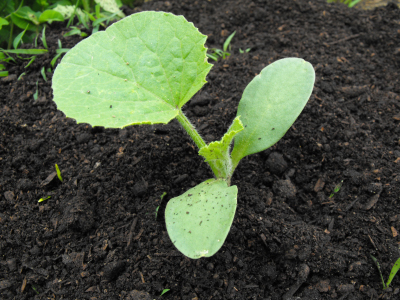
Top dressing
 We
have a horrible time with most of our cucurbits. Even before the
squashes fall prey to the vine borer, the cucumbers and
canteloupes come down with powdery mildew. Or maybe it's cucumber
mosaic or bacterial wilt. All I know is that the plants start to
bloom, then they keel over.
We
have a horrible time with most of our cucurbits. Even before the
squashes fall prey to the vine borer, the cucumbers and
canteloupes come down with powdery mildew. Or maybe it's cucumber
mosaic or bacterial wilt. All I know is that the plants start to
bloom, then they keel over.
I've never seen data to
back this up, but many organic gardeners
believe that pest and disease infestations originally stem from ill
health on the part of your crop. The idea makes sense --- if we
don't eat a well-rounded diet, we're more likely to catch a cold, so
why wouldn't the same
be true of our cucurbits?
Following this
reasoning, I top-dressed all of our baby cucurbits with a hearty scoop
of compost, hoping to perk them up so they'll outgrow their diseases
(and the weeds.) Native Americans used a similar idea when they
planted squash on hills of dirt over fresh fish. Maybe I'll get
lucky this year and taste our first home-grown canteloupe?
Want more in-depth information? Browse through our books.
Or explore more posts by date or by subject.
About us: Anna Hess and Mark Hamilton spent over a decade living self-sufficiently in the mountains of Virginia before moving north to start over from scratch in the foothills of Ohio. They've experimented with permaculture, no-till gardening, trailersteading, home-based microbusinesses and much more, writing about their adventures in both blogs and books.
Want to be notified when new comments are posted on this page? Click on the RSS button after you add a comment to subscribe to the comment feed, or simply check the box beside "email replies to me" while writing your comment.

My brother upgraded ikiwiki this past weekend --- hopefully login will be easier, but if it's harder, let me know!
You might check out http://www.google.com/hostednews/ap/article/ALeqM5jNo1tp-n1YFW0VWRSWCD04vJtfhAD9FL5BK00 --- it has some useful information about the blight.